January 16, 2009
Air Date: January 16, 2009
FULL SHOW
SEGMENTS
Labor Leader’s Green Leanings
/ Ingrid LobetView the page for this story
Hilda Solis, Barack Obama’s pick for Labor Secretary, has been a pioneer in getting barrio kids into college to train for green jobs. Living on Earth’s Ingrid Lobet looks at some of the forces that shaped California Congresswoman Hilda Solis. (06:50)
Passing the Test
/ Jeff YoungView the page for this story
The people who will push the new president's ambitious agenda on clean energy and climate change passed their first hurdle: confirmation hearings in the U.S. Senate. Now the real work begins for the future heads of the Energy and Interior Departments and the Environmental Protection Agency. Living on Earth's Jeff Young talks with host Steve Curwood about the hearings in Washington. (09:40)
Helping the Prez, Greening the Rez
View the page for this story
Armed with big potential for wind and solar generation, Native America says it's ready to help Barack Obama build a green economy. A policy statement, signed by 250 tribes and tribal organizations and submitted to the new administration, outlines ways to tackle global warming while addressing unemployment and fuel poverty on tribal lands. Economist Winona LaDuke, director of Honor the Earth, talks with host Steve Curwood about the need to develop tribal economies without degrading tribal lands and beliefs. (08:05)
Made in China
View the page for this story
A Chinese car company recently began selling a plug-in hybrid electric car in China. Paul Scott of Plug in America tells host Steve Curwood that it will still be at least two years before automakers have similar technology in the United States. (05:15)
Cool Fix for a Hot Planet
View the page for this story
A Massachusetts listener suggests a real estate tax break for green homes. (01:10)
Wildlands Philanthropy
View the page for this story
Conserved lands like Muir Woods National Monument might be dear to American hearts, but few know about the people behind the places. Tom Butler, author of "Wildlands Philanthropy," tells host Steve Curwood about some of the love stories between America's wild places and the people who helped keep them wild. (06:10)
The Language of Landscape
/ Eva SaulitisView the page for this story
Living on Earth continues its series exploring features of the American landscape. The series is based on the book “Home Ground: Language for an American Landscape,” edited by Barry Lopez and Debra Gwartney. In this installment, marine biologist Eva Saulitis of Homer, Alaska gives her definition of “anchor ice.” (02:15)
Ode to Powerlines
View the page for this story
Power lines give a pulse to the American landscape. So say cartographer Brian Rosa and photographer Adam Ryder who walked, camped, and lived in the shadow of Rhode Island’s power lines to try to understand how they impact the environment and people. Producer Ike Sriskandarajah (Srees –kahn-da-ra-jah) uncovers how the ubiquitous pylons and lines capture the imagination. (06:15)
This week's EarthEar selection
listen /
download
Winter winds blow in Glen Cannich, Inverness-shire, Scotland
Show Credits and Funders
Show Transcript
Host: Steve Curwood
Guests: Tom Butler, Winona LaDuke, Paul Scott
Reporters: Ingrid Lobet, Ike Sriskandarajah, Jeff Young
Commentator: Eva Saulitis
[THEME]
CURWOOD: From Public Radio International - this is Living on Earth.
[THEME]
CURWOOD: I’m Steve Curwood.
It’s confirmation time for the leaders of the Obama Administration, and some, like the choice for the energy department have been getting lessons in politics. Dr. Stephen Chu once said this about coal:
CHU: Coal is my worst nightmare.
CURWOOD: But when he got to Capitol Hill he said this:
CHU: Coal is an abundant resource in the world and the United States, I believe, will not turn their backs on coal.
CURWOOD: Also, the child of an immigrant shop steward becomes Secretary of Labor
MOLINA: To see someone like Hilda from the neighborhood, from our community, now to be a top cabinet member. For me, it’s very dramatic. I’m not so sure I was going to see it in my lifetime.
CURWOOD: And paying homage to America’s high-tension power lines.
[ZAP]
CURWOOD: These electrifying stories and more this week on Living on Earth. Stick Around!
ANNOUNCER: Support for Living on Earth comes from the National Science Foundation and Stonyfield Farm.
[THEME]
Labor Leader’s Green Leanings
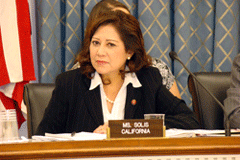
(Courtesy of Hilda L. Solis)
CURWOOD: From the Jennifer and Ted Stanley Studios in Somerville, Massachusetts - this is Living on Earth. I’m Steve Curwood.
What do former Senator Elizabeth Dole and former Secretary of State George Shultz have in common?
They were both Secretary of Labor, they also had Ivy League educations, and neither grew up in union households. They are in direct contrast to Barack Obama’s pick for Secretary of Labor, California Congresswoman Hilda Solis. Not only does she come from a union family, that family had to deal with hazardous working conditions, now Hilda Solis will oversee the Occupational Safety and Health Agency, including mine safety, and enforce the nation’s labor laws. She’ll also put into action the Obama plan to train workers for the new, green economy. Living on Earth’s Ingrid Lobet has our report.

Congresswoman Hilda Solis has represented the San Gabriel Valley at the state and federal level (Photo: Ingrid Lobet)
LOBET: Hilda Solis's mother was born in Nicaragua. Her father was born in Mexico. And she was born, the third of seven kids, in the blue-collar Los Angeles suburb of La Puente.
MOLINA: To see someone like Hilda from the neighborhood, from our community now to be a top cabinet member.
LOBET: That's Gloria Molina, the first woman, and the first Latina elected to the powerful Los Angeles County Board of supervisors, 18 years ago.
MOLINA: For me it's very dramatic. I'm not so sure I was going to get to see it in my lifetime.
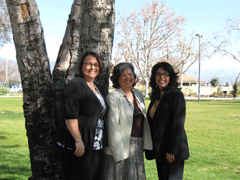
Veronica Dolleschel (City of El Monte), Belinda Faustinos (San Gabriel Mountain Conservancy) and Norma Edith Garcia (L.A. County) have worked with Rep. Solis on public green space and green jobs projects like this one, Rio Vista Park. (Photo: Ingrid Lobet)
LOBET: Molina and Solis both represent the San Gabriel Valley. It's an area of contrasts: small neat houses, beautiful mountains, at least on a clear day, and says Belinda Faustinos of the San Gabriel Mountains Conservancy:
FAUSTINOS: The most landfills and the most gravel pits that there are in the nation in one concentrated area.
LOBET: The neighborhoods are also home to manufacturing, and the good jobs that come with it. In her own home growing up, Hilda Solis had a daily, first-hand view of the tradeoffs some employees made when they worked in the trades.
SOLIS: I look at my own father's previous career, who worked at a battery recycling plant - not a great job, paid well, but nobody wanted the job, so he did it for 20 years, and now he is suffering from all kinds of health ailments because of contaminants, toxins and no safety equipment at the time.
LOBET: It's remarkable that someone with this proximity to heavy work will now oversee the nation's workplace safety programs. Solis' parents weren't just blue collar, they were union members and her dad was a shop steward. But Gloria Molina says businesses shouldn't fear that Solis will over-regulate, because she also understands more than most the importance of employment like her father's.
MOLINA: You can regulate all day long and in many instances you regulate those businesses right out of the neighborhood, right out of the community. And those jobs are important. Hilda's family would not have survived had he not had a job of that type.
[CHILDREN RUNNING IN SCHOOLYARD, MUSICAL INSTRUMENTS, BIRDS]
LOBET: In a playground in El Monte, preschoolers run in circles, clasping bells and maracas. Their yard looks out on a new public park, landscaped in native plants, the tale of a historic berry strike etched in the concrete. Belinda Faustinos says more than a decade ago, Hilda Solis saw the need for relief from the concrete and created the Conservancy that's funding this and other green places in the region.

(Courtesy of Hilda L. Solis)
FAUSTINOS: I mean she definitely was one of the first people I encountered in the legislature that I worked with who had this personal commitment to open space.
LOBET: After creating the San Gabriel Mountains Conservancy to channel funding, Faustinos says Solis helped set it up so local people would be trained, at the college level, to actually build the parks.
FAUSTINOS: And they recruited children, local youth to train them basically to doing native landscaping for instance to make sure they understood how to put in filtrations system to allow for groundwater recharge. So they partnered with Rio Hondo College and some of the professors there to provide for training modules for the students.
LOBET: So Solis has been advocating for green jobs since before the term was common.
SOLIS: Thank you and Buenos Dias.
LOBET: Last Fall she addressed the Center for American Progress.
SOLIS: To me we are on the cusp of really changing the way we think about manufacturing, the way we think about job creation and the way we think treating the environment. In many ways I believe this is the new industrial green revolution.
LOBET: In Congress Solis introduced legislation to ease the cost of future climate change legislation on low-income people. She pushed for retraining for environmental jobs, for changes in how chemicals are regulated, and for limits on diesel soot from international shipping because of the impact on portside communities.
SOLIS: I have seen actually these air filters and I couldn't believe it. I thought, “How could that happen?” In the course of 24 hours you see a white sheet and 24 hours later, it is entirely black. That is affecting our respiratory tracts, cancer and all the other things that bring down the health and wellbeing of the communities that live around those areas, around the ports.
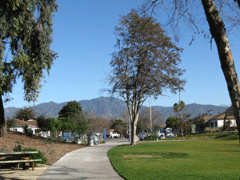
The San Gabriel Mountains, visible on clear days, frame a public park that youth conservation corps members helped build, on land Rep. Hilda Solis helped protect. (Photo: Ingrid Lobet)
LOBET: But when it came time for Congresswoman Solis to appear before the Senate Labor Committee as part of her confirmation, Senators didn't have these issues on their minds. Democrats wanted to know whether Solis would commit to supporting paid family leave, addressing the shortage of nurses and high unemployment among people who are disabled.
Republicans wanted her to promise to maintain a private voting process in workplace union elections, rather than just letting employees sign cards saying they want to join. They were not satisfied with Solis's answers to that question, nor to whether she agrees that employees in a union workplace should be able to opt out of that union. Here's Senator Lamar Alexander of Tennessee.
ALEXANDER: Will you oppose any attempt to change the right of states to enact a Right To Work law as 22 states already have?
SOLIS: That is something that--I believe that I am qualified to address that at this time, that is not something that I have personally discussed with the president elect.
LOBET: And Republican Senator Mike Enzi of Wyoming asked Solis whether non-union contractors would still be able to compete on government contracts.
SOLIS: I think that is something I am not able to speak to you at this time but will like to review and come back to you personally on this matter.
ENZI: Okay... so far we have three reviews.
LOBET: Despite the concern over her labor background, it's expected that Hilda Solis, the Congresswoman from California's 32nd district, will soon be United States Secretary of Labor.
For Living on Earth, I'm Ingrid Lobet in Los Angeles.
Passing the Test
CURWOOD: By and large, the other key members of Barack Obama’s team will easily win confirmation in the Senate. But confirmation hearings gave a hint of the very tough job ahead for the people who will lead the Interior and Energy departments, and the Environmental Protection Agency. Living on Earth’s Jeff Young joins us now from Washington with more on, what I guess you could call, the Big Three cabinet positions when it comes to energy and the environment.
YOUNG: I think that’s right Steve—energy, interior, and EPA—those three will be the ones on the front lines with this ambitious agenda that Obama has set for clean energy and climate change. And it’s a huge job—let’s be clear, if he sticks to the plan he outlined during the campaign this means changing the very basis of our country’s energy economy, no small job. And that’s in addition to the other very important work these agencies do. The Senators who questioned these nominees say Obama has picked highly qualified people who are up to the job: Lisa Jackson of New Jersey’s environment department to lead the EPA; Senator Ken Salazar of Colorado for the Interior Secretary post; and physicist Steven Chu for Energy Secretary.
CURWOOD: Jeff I want to focus on Steven Chu because his credentials really stand out—he’s got a Nobel Prize, he was in charge of one of the country's top energy laboratories at Lawrence Berkeley. But I take it some of his past public comments might have ruffled a few feathers in the Senate?
YOUNG: For years Chu has been very outspoken about the danger of climate change and our continued dependence on fossil fuels. He has talked about the need for higher fuel prices if we want to spur development of alternatives, and he’s expressed deep concern about coal in particular. So there was a lot of attention to those statements.
CURWOOD: Yes, saying things as a scientist is one thing but as a nominee for energy secretary, well, that’s quite another. So did he backpedal on any of those, Jeff?
YOUNG: On some, yes, and on others he stood his ground. The very first thing Chu stressed in his testimony was the importance of dealing with climate change:
CHU: Climate change is a growing and pressing problem. It is now clear that if we continue on our current path, we run the risk of dramatic disruptive changes to our climate in the lifetimes of our children and our grandchildren.
YOUNG: Chu says Obama is committed to a cap and trade system to control greenhouse gas emissions and put a price on carbon. And Chu is still very gung ho—to use his words—on energy efficiency and renewable energy. That was the major focus of his work at the Lawrence Berkeley lab and it’s where he got most excited in the hearings.
CURWOOD: So all of that is consistent with what we’ve heard from him before, where did you hear Dr. Chu backing away from some things he’s said?
YOUNG: On coal and on gas prices, he had to do a little dancing. For example this was Chu speaking at an event two years ago, back when he was just an outspoken scientist, talking about coal:
CHU: We have lots of fossil fuels. That’s really both good and bad news. We won’t run out of energy but there’s enough carbon in the ground to cook us. Coal is my worst nightmare.
YOUNG: Well that was then. This is Chu now as energy secretary nominee:
CHU: I said that in the following context. If the world continues to use coal the way we’re using it today, and the world I mean, in particular not just the United States, but China, India, and Russia, then it is a pretty bad dream. But I also say, many times in my talks, that coal is an abundant resource in the world. India, China, Russia and the United States will not turn their backs on coal, so it is imperative to figure out a way to use coal as cleanly as possible.
YOUNG: And once upon a time, Chu once expressed doubts about carbon capture and storage - what’s sometimes called clean coal - and whether that could work. Now he supports increasing investment in carbon capture.
He also had to pull back from earlier statements about the price of gas. Last year he told the Wall Street Journal he thought we should be paying about what the European Union pays for gas. Well, none of that talk now. He makes it clear he’s sensitive to consumer concerns about gas prices and any talk of a gas tax is off the table.
CURWOOD: Jeff, what about nuclear power? That’s an area where Obama has seemed deliberately vague. Did Chu clarify things at all?
YOUNG: He still preferred to keep it a bit vague. He said he’ll speed up the government’s guaranteed loan program - that’s very important to the nuclear industry to build new power plants. But he’s also concerned about the very high cost of nuclear power.
As for the waste issue, I thought it was very interesting that Mr. Chu said he wants more research into reprocessing nuclear waste. That’s controversial because while it can cut the amount of radioactive waste it can also increase the material that could be used in nuclear weapons.
And on all of these, Chu made it clear that he will follow the science when making big decisions. That’s something I heard all three of these nominees say: science will be our guide. To my ears, that was a sort of implicit rebuke of the Bush administration and the way it’s been setting policy.
CURWOOD: Jeff, stick around because after the break I want to her more about how these nominees say they will address the question of sound science.
You’re listening to Living on Earth.
[MUSIC: Thunderball “Angela’s Lament” from Scorpio Rising (Eighteenth Street Lounge 2001)]
CURWOOD: It’s Living on Earth, I’m Steve Curwood.
JACKSON: Science must be the backbone of what EPA does. If I am confirmed, political appointees will not compromise the integrity of technical experts to advance particular regulatory outcomes.
CURWOOD: That’s Lisa Jackson, the woman president-elect Obama has picked to lead the U.S. Environmental Protection Agency.
Living on Earth’s Jeff Young is telling us what we learned about Ms. Jackson and the others on Obama’s environment team during their Senate confirmation hearings.
And Jeff, it sounds like Ms. Jackson wants to change how EPA’s been doing business?
YOUNG: There’s a new sheriff in town. That was kind of the theme for all of these nominees who said, we realize there are big problems with the way these agencies have operated and we will fix those.
For much of the past eight years the EPA has simply not been making policy based on what its own scientists recommend. Whether it was climate change or clean air we heard consistent complaints from staff scientists and science advisory boards that they were ignored or overturned. The agency has also been very slow—deliberately slow, some would say—in its response to a Supreme Court decision on global warming. All of this means Jackson will inherit a lot of unfinished business.
CURWOOD: And the biggest one probably is what to do about regulating greenhouse gases. Is she going to use the Clean Air Act to limit CO2?
YOUNG: Jackson indicated she is willing to use that authority but she wants to work with Congress as they address climate change through new legislation. So right out of the gate, she says she will review the waiver that California and other states want that would allow them to limit the CO2 from autos. The Bush EPA denied that waiver. If Obama’s EPA approves it that means about half the US auto market would have to meet much higher standards for fuel efficiency.
Now as for limiting CO2 from industrial sources, again, Jackson prefers to give Congress time to act. And she sought to ease business concerns about that.
JACKSON: One thing I can pledge is we will be reasonable, thoughtful and deliberate as we move toward our future, as we begin to address global warming gases.
YOUNG: But one way or the other—whether it’s Congress writing new law or EPA using existing law - we are headed toward limits on greenhouse gases. And that’s one thing Jackson worked on a lot when she ran New Jersey’s environmental department.
CURWOD: What about other things EPA deals with—toxics, hazardous waste cleanup—did you get a sense of her priorities there?
YOUNG: There are a few specific issues I think she’ll act on soon. She says she’ll review the agency’s inaction on perchlorate—that’s a rocket fuel ingredient that’s tainted drinking water in more than half the states. And there will be an effort to regulate the toxic fly ash left over from coal fired power plants. Those recent fly ash spills in Tennessee and Alabama highlighted the dangers of leaving those waste piles unregulated. And then of course there’s Superfund. The program that’s supposed to be cleaning up the country’s worst toxic waste sites is chronically under-funded. And about 90 of the sites on the list are still threatening human health. Jackson will feel heat to do something on that.
CURWOOD: Jeff, the Interior Department is the other key player here. Colorado Senator Ken Salazar looks like a lock to be the new Interior Secretary. Tell me about what he plans to do there.
YOUNG: Interior is such an important department—altogether they manage about 20 percent of the entire country’s landmass. And almost everywhere you look in that 20 percent you see big thorny issues to deal with—national parks don’t have money for maintenance, mining and drilling on public lands is leaving a mess behind, and then there’s the offshore drilling question. Ken Salazar is going to have his hands full just with those—but wait, there’s more. He’s also going to have to clean up the ethical mess left behind by the outgoing administration.
CURWOOD: Ah yes, I remember something about interior department officials getting a little too cozy with the energy companies they were supposed to be regulating.
YOUNG: That’s a polite way of putting it. In one office interior department workers were actually sleeping with oil company workers. Another high-ranking interior official was convicted on corruption charges related to the Jack Abramhoff scandal; and another left her job after scientists said she forced them to change data on endangered species studies. Democratic senator Ron Wyden of Oregon put it in perspective in this exchange with Salazar.
WYDEN: You have some heavy lifting ahead. In political suites in interior they have regularly been trampling science. Now you have to go in there and drain the swamp.
SALAZAR: We will be working on that from day one.
YOUNG: Now Salazar got nothing but praise form his old senate colleagues. All three of these confirmation votes - Salazar, Jackson and Mr. Chu at energy—are slam dunks. But the jobs ahead for them are anything but. If they’re serious about the agenda they’ve laid out—to really address climate change and really reform these agencies—well I think they’re walking into three of the toughest jobs in Washington.
CURWOOD: Living on Earth’s Jeff Young in Washington. Thanks.
YOUNG: You’re welcome, Steve.
Related links:
- Listen to Living on Earth’s profile of EPA nominee Lisa Jackson
- A lecture by Energy Deptartment nominee Steven Chu on climate change
- The Senate website for Interior Department nominee Ken Salazar
Helping the Prez, Greening the Rez

Winona LaDuke, rural development economist, environmentalist, and member of the Ojibwe tribe of Minnesota. (Courtesy of Honor the Earth)
CURWOOD: When it comes to U.S. energy policy and Native Americans, the record's pretty poor. Uranium and coal mining have brought pollution to native communities and lands - but relatively few jobs - and rising sea waters due to fossil fuel consumption are forcing native villages in Alaska to abandon their coastal lands.
But now that Barack Obama has brought his promise of a lean, clean economy to the White House, many tribes are feeling hopeful. So hopeful, in fact, that a green policy statement representing more than 200 tribes and tribal organizations has been submitted to the Obama team.
Winona LaDuke is a rural development economist and writer - you might know her as Ralph Nader's running mate on the Green Party ticket in the 2000 presidential elections. She now directs Honor the Earth, a non-profit that helped draw up the green petition, which outlines what Native America needs from the Obama administration, and what the Obama administration needs from Native America.

Winona LaDuke, rural development economist, environmentalist, and member of the Ojibwe tribe of Minnesota. (Courtesy of Honor the Earth)
LADUKE: We have this vast potential for renewable energy. The best potential in the whole country comes from Indian tribes and Indian tribal communities. We have been the most impacted by the last energy economy of anyone. And what we need to do is to capitalize the next energy economy in Indian country on terms that are just and are fair. So that we aren't selling our wind rights out to major corporations, you know, and just receiving a pittance. I'm relatively aware of the fact that 1) the Obama administration has inherited a huge mess and 2) the Obama administration is full of vital energy to make a change. So we have infused our strategy, saying that you want a green economy? This is what a green economy looks like in Indian Country, and this is how you would do it.
CURWOOD: So what is it that you're asking the Obama administration to do?
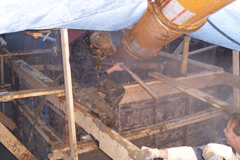
Members of the Ojibwe tribe pour the foundation for a 75 kW wind turbine on the White Earth Reservation. (Courtesy of Honor the Earth)
LADUKE: What we are asking the Obama administration to do is 1) increase tribal capacity in training to create a work force that is able to move into renewable energy through financing. We are asking them for energy assistance, efficiency work, because most of our homes are trailers on our reservations, and, in addition to that, homes that are already up are highly inefficient. So in order to reduce fuel poverty in Indian country, we have to have efficient homes. We are asking for renewable production refund for tribal projects that can't utilize tax credits in order to ensure that tribal governments are able to capitalize renewable energy in Indian Country. We are asking for access to the federal grid in ways that will address tribal ability to bring our projects online at a level that is meaningful both for tribal economies and to address climate change.
CURWOOD: Now, your organization also made it very clear that you don't want to see the U.S. pursuing nuclear energy and what's been called clean coal. Why is that?
LADUKE: Well clean coal doesn't exist. You can't wash it enough, you can't – strip mining or blowing off the top of a mountain is not clean. There's no way to clean up coal. And so, we just think that we shouldn't waste our time and the billions or trillions of dollars that it would take to try to sequester something for forever – because that is what you would have to do is for forever. So just leave it in the ground. Nuclear power – our tribes have been heavily impacted and are presently impacted by uranium mining. We are fighting uranium mining out in South Dakota and in Nebraska and all through the north. You know we have thousands of abandoned uranium mines and thousands of people who are impacted by radiation exposure. Nuclear is expensive, is dangerous and is not the answer to climate change. There is no way you can bring enough nuclear power plants on line in time to address climate change disasters. What we need to do is we need to put the money that would be wasted on clean coal and wasted on nuclear power into a full scale efficiency, renewable economy that treats people with dignity and doesn't treat people as second class citizens and assume that we can dump our waste in third world countries or in Indian reservations.
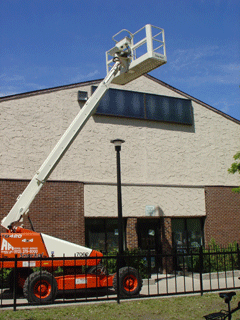
Installing solar panels at Little Earth in Minneapolis. (Courtesy of Honor the Earth, Photo: Aimee Loiselle)
CURWOOD: So, let's look at some specifics here Winona LaDuke. I understand about a hundred tribes have already done some feasibility studies to look at what could be done in terms of wind and solar energy generation. What are those numbers? What kind of potential are we looking at here?
LADUKE: So the United States needs to produce about 185,000 megawatts of green power in the next decade in order to address climate change. That is the reality. Tribal communities are probably in a position to produce about 120,000 megawatts of that. Between wind potential, they're saying that our tribal communities have the potential to produce about one third of present installed U.S. electrical capacity to massive solar projects that are, you know, tribal projects and have the potential to feed into the present grids and create a green energy that will help this country address climate change. So, we are the people of color with land and natural resources, that's what distinguishes us, aside from other things, from other communities of color. And on that land, we have some of the windiest places in the country. Go figure how that happened – but the northern plains – you know, even in my reservation we have very high wind potential. I just finished last week putting up the foundation for a wind turbine at my office in Callaway, Minnesota. It's a 75 kilowatt wind turbine. My tribe is looking at – and other tribes in our area are looking at about four more megawatts of power coming online probably within the next two to three years.
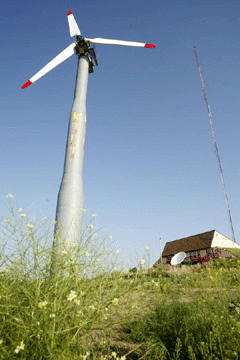
A wind turbine at the Pine Ridge Reservation in South Dakota powers a Lakota radio station. (Courtesy of Honor the Earth, Photo: Keri Pickett)
CURWOOD: Certainly the need for economic development on Native lands is really as impressive as the renewable energy potential that you have with your very high unemployment rates. And I think, in fact, a lot of reservation households don't even have electricity. So to what extent do you think that green jobs, green infrastructure, green energy is gonna get those figures turned around, to make change that has yet to come to Indian Country some two hundred plus years into the life of this country?
LADUKE: I am very hopeful. That is to say, I look at my own reservation the White Earth reservation in northern Minnesota – on my reservation, one quarter of our money is spent on energy. All of that money basically goes to off reservation vendors whether it is for electricity or whether it is for fuel. You know a quarter of our income is a substantial economy for our reservation and for any reservation. And so our strategy is to replicate what we are doing in White Earth, you know, nationally, and say instead of outsourcing, we can re-localize a good portion of our energy economy. But we need the jobs in our communities. We need joint ownership or ownership of the wind power production and the solar power productions so that the revenues return to our tribal communities. We need to be employed in those, because we have 60% unemployment on my reservation, and, you know, the average age of a Native person is, you know, like 20, 21 years of age and you could either send my young man off to jail or you could employ him or send him to the military.
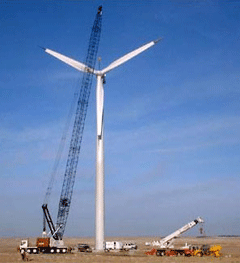
In 2003, the 750-kW turbine on the Rosebud Sioux reservation became the first commercial wind turbine to be installed, owned and operated by an American Indian tribe. (Courtesy of Intertribal Council on Utility Policy)
LADUKE: I think that the present time is good. My youngest son, his name is Gwaconamont Gasko (sp). And Gwaconamont in our language means when the wind shifts. And that is what is happening now; the wind is shifting. And we have a chance to do something great for the generations that have not yet arrived here. You know, we've battled for years to create a society which is not based on conquest, but is based on survival. And the Obama administration, with the intersection between the realities of a shrinking, unsustainable economy, climate change, fuel, poverty and peak oil, we have the chance to make an economy that will reaffirm a relationship to the land. And so, I'm very optimistic. The next economy will not affect our sacred sites, our rivers, our lakes, our mountains, because the next economy will not require their consumption.
CURWOOD: Winona LaDuke is the executive director of Honor the Earth, one of the Native American groups who drew up a green policy statement for the Obama administration and a former candidate for vice president of the United States under the banner of the Green Party. Winona, thanks so much for your time.
LADUKE: Thank you, Migwich (sp)
CURWOOD: Migwich (sp)
Related links:
- Click here to read the policy statement “Environmental Justice in Native America and the Next Administration.”
- Honor the Earth
- Intertribal Council on Utility Policy
[MUSIC: Thunderball “Angela’s Lament” from Scorpio Rising (Eighteenth Street Lounge 2001)]
Made in China

The BYD, or Build Your Dream car, made its debut at the Detroit auto show.
CURWOOD: BYD is making a big splash at this year’s Detroit Auto Show. The Chinese car company is showcasing its plug-in electric hybrid that it sells domestically in China. BYD – which stands for Build Your Dream - hopes to soon sell the cars in Europe and the United States where you still can’t buy a plug- in hybrid. Here to give us an update on electric and plug-in hybrid cars is Paul Scott.
He is a board member of Plug In America, a non-profit group that’s keeping the electric car dream alive in the United States. Welcome to the show, Paul Scott.
SCOTT: Thank you very much.
CURWOOD: There are many people who are waiting for an all electric or plug-in hybrid car here in the United States, so if you're in China today, you can get a BYD, get a plug-in hybrid, but we won't get them here in the United States for – what – another year or two. Why all the delay?
SCOTT: Yeah, a lot of it has to do with the carmakers passed laws years ago to make it difficult for foreign companies to come in to the United States. It's good in that the cars sold in the United States are very, very safe. But it does present a barrier to coming in and selling here. So the BYD people are selling their vehicle in China right now, but in order to pass all of our regulations, they're gonna have to rebuild it a little bit, make it stronger and so forth, so it can withstand the crash testing.
CURWOOD: Over these next few years, we have the price range of what - $22,000 that the Chinese BYD is being sold for. The Chevy Volt is apparently going to go for 40 K when it hits the market, and of course, there's the Tesla at 100,000. What prices do you expect from the other manufacturers working on electric cars?
SCOTT: It'll range. For pure electric cars, for instance a City Car, which is a small maybe smart sized car, pure battery electric version of that with a 100-mile range, should sell for around 25 or 30. That's a very reasonable price when you consider the cost of operation is very, very low. Now you have no tune-ups, no maintenance whatsoever on these vehicles, and the price of electricity nationally is about 10.4 cents per kilowatt hour. So that's about equivalent to buy gas at about 75 or 80 cents a gallon.

The BYD, or Build Your Dream car, made its debut at the Detroit auto show.
SCOTT: The capacity is pretty substantial. You know, we have to build electric load capacity to meet peak loads during the day, and so there's all this excess capacity at night that goes unused. And there's enough there to recharge 73% of the American fleet, which is something north of 180 million vehicles. And that we could do today without adding any capacity to the grid.
CURWOOD: So what other companies and countries are you keeping your eye on? Who do you think will really be able to deliver plug-in hybrids over the next year or two and how soon will we get all electric cars and where?
SCOTT: I would say Toyota is certainly the one to watch on the plug-in hybrid side, along with the Chevy Volt from GM. There are others, certainly Mitsubishi, Nissan and Volvo. A lot of the German car makers are starting to get into plug-in hybrids as well, Volkswagon certainly. So I think you're gonna see a whole lot of them in two to three years. But in the next year, probably no plug-in hybrids in the U.S. I think it's gonna be at least two years before we see them here.
CURWOOD: And now what about all electric cars, how soon will we see those here in the U.S.?
SCOTT: A bit sooner because they're a simpler car to make.
CURWOOD: Really?
SCOTT: Oh yeah. Yeah. There's no joining up an internal combustion engine and trying to make all that work together. You put a motor, controller and batteries in a car and it goes. We had battery electric cars back in 1890s, so you know, a person born before the Civil War could have driven a battery electric car. And so you're gonna have those, I think, on the market within twelve months and possibly much sooner than that.
CURWOOD: Is there in existence anywhere an EV1 that escaped the crusher?
SCOTT: [Laughs] Yes, there is. The story is – and I've got this on pretty good authority – that a woman was told to bring her car in to the dealership. She did so, went in, and was told “oh, our records show we already have this car.” So she got back in and drove away. And that car is in Southern California from what I understand. I don't know who it is – I honestly don't, but I wish them well, because that's a million dollar vehicle at this point.
CURWOOD: Paul Scott is a member of the board of directors of Plug In America and a driver of an all electric car and an all electric motorcycle. Thank you sir.
SCOTT: Thank you very much.
CURWOOD: Just ahead: America’s conservation philanthropists. Put your money on Living on Earth.
Related links:
- Plug in America
- North American International Auto Show in Detroit
[MUSIC: (Tom Verlaine “Old Car” from Warm And Cool (Thrill Jockey Records 1992)]
[MUSIC: The Bad Plus: Variation d’Apollon from For All I Care (Heads Up 2009)]
Cool Fix for a Hot Planet
CURWOOD: It's Living on Earth, I'm Steve Curwood. Coming up: the secret life of power lines.
But first, listener Alex Lehar of Lexington, Massachusetts wants to give green homeowners a tax break. Here’s his Cool Fix for a Hot Planet.
[COOL FIX THEME]
LEHAR: Currently real estate taxes are levied on the basis of how big your house is, how many windows there are, how many bathrooms there are, and so on. Why not extend that assessment method by introducing a green co-efficient for a house, which is an assessment of how much energy efficiency might be built into the house? And give people a tax break based on that and, thereby, achieve some of the objectives of energy efficiency in our society…and, also, generate a whole industry, which would supply the services needed to do that.
CURWOOD: And if you have a Cool Fix for a Hot Planet, let us know. If we use your idea on the air, we'll send you a sleek cool-blue Living on Earth tire gauge. Keep your tires properly inflated and you could save over $280 a year in fuel costs. That according to a study done at Carnegie Mellon University. So, call our listener line at 800-218-9988, that's 800-218-99-88. Or email coolfix—that's one word—at loe.org. That's coolfix@loe.org.
Wildlands Philanthropy
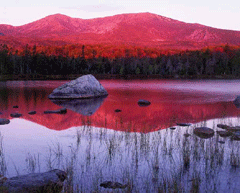
Baxter State Park, in Maine. (Photo: © Antonio Vizcaino/America Natural)
CURWOOD: Visitors to our country's majestic parks and nature preserves don't usually forget their experiences. Walking among the giant redwoods of Muir Woods National Monument or taking in the vast expanses of sky and land in Sevilleta National Wildlife Refuge... tend to leave a mark.
But the people who conserved these lands, are - for the most part - forgotten. Until now. Writer Tom Butler has researched America's conservation philanthropists... from the rich and famous like John D. Rockefeller Jr. to school teacher Mary Wharton - to members of conservation land trusts-- who collectively buy up local land to keep it protected. In collaboration with photographer Antonio Vizcaino, Mr. Butler compiled 40 of these stories into a new book called "Wildlands Philanthropy: The Great American Tradition." Tom, thanks for joining me.
BUTLER: Thank you very much.
CURWOOD: Why did you write this book?

Baxter State Park, in Maine. (Photo: © Antonio Vizcaino/America Natural)
BUTLER: There are thousands of wild places, protected natural areas, literally from sea to shining sea, from Alaska to Tierra del Fuego, across the country and around the world, and this tradition of wildlands philanthropy is something that has profoundly affected the American experience – millions of us. We take our children to the Smokies to go camping or we stroll among the cobble beaches of Acadia National Park. We enjoy these places, which in many cases have come to embody our very idea of America the Beautiful. And yet relatively few people have any idea that there were people – individuals or small groups – using their own private passion and energy and time and personal wealth to save these places for the future.
CURWOOD: Your book begins with Muir Woods National Monument and probably for good reason because it's such an amazing place. You leave the clamor and clatter of San Francisco. You drive over the Golden Gate Bridge and it doesn't take you very long to be really, I think, one of the most amazing places on earth. The height of the redwoods is like being in a cathedral or something, and I was surprised to learn that it wasn't the conservationist John Muir who was behind the conservation there, but this couple William and Elizabeth Thatcher Kent. They were also responsible for an adjoining state park. Who were these people?
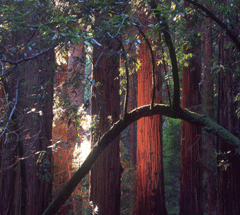
Muir Woods National Monument, in California. (Photo: © Antonio Vizcaino/America Natural)
BUTLER: William and Elizabeth Thatcher Kent were a progressive Marin County couple who in 1905 bought the very last tract of old growth coast redwoods that existed in the San Francisco Bay area. All the others had been logged out. Well, a private utility developer approached William Kent and offered to buy his land. He wanted to skim off the giant trees, dam Redwood Creek and create a private reservoir. And Kent realized that fighting the eminent domain process that the developer had commenced was likely to be difficult. And so he circumvented the developer. He bundled up the deeds to about 295 acres including that great cathedral grove in Muir Woods and sent it off to the secretary of the interior, who was Garfield, and asked that President Teddy Roosevelt use the Antiquities Act and declare a national monument. And he specifically asked that it be named for that great early wilderness conservationist, John Muir. And Teddy Roosevelt did just that. But he also wrote Kent back a letter and said essentially this is a grand gift and a wonderful thing you've done, but shouldn't we name it Kent National Monument because you're the one giving the land? And William Kent wrote the President back and said “I've got four rugged boys that I'm raising up to be manly men like you, Mr. President, and if they can't keep the name Kent alive, then I'm content it should be forgotten.”
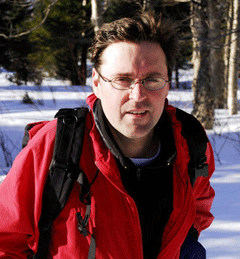
Author Tom Butler. (Photo: © Antonio Vizcaino/America Natural)
[LAUGHING]
BUTLER: And moreover, he didn't want to – and here I'll quote directly – he didn't want “to stencil one's own name upon a benefaction.”
CURWOOD: Now, going through your book, Tom, many of the stories involve folks who – well, frankly, they had a lot of dough. And I think the Kents were a fairly affluent family who could afford to write a check for this amazing piece of old growth, but you also have a story in here about a couple of women who, well, put a preserved area on their credit cards.
[LAUGHING]
CURWOOD: This is the fresh tracks story.
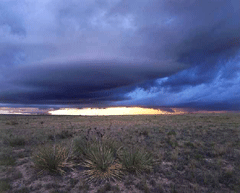
Fresh Tracks Nature Preserve, in Colorado. (Photo: © Antonio Vizcaino/America Natural)
BUTLER: This was just a few years ago. Two amazing young women, they were graduate students at the University of Colorado. And in between their studies they were also conservation activists, particularly with an animal defense group that was busy trying to prevent the sort of horrific prairie dog massacres that were then legal in Colorado, where gunners would go out to a prairie dog town and blast away and turn the little prairie dogs – which are, of course, a keystone species in the short grass prairie ecosystem – they would turn them into a fine red mist. There was even a sort of red mist subculture. Well, these two young activists were among a group that would go and try to block these prairie dogs shoots by chaining themselves with bike locks or the like in front of the gunners. And time after time they would get hauled away by the police. And on one long holiday weekend, they were sitting in the Kit Carson County Jail, in Colorado, and they began thinking, well what can we do to more effectively protect these creatures and this habitat that we love? And they founded a land trust. They raised money, they used credit card - initially – debt to help pay off the mortgage payments on a tract of about 1200 acres of short grass prairie in eastern Colorado which they bought and protected as the Fresh Tracks Nature Preserve.
CURWOOD: Tom, I want to ask you, how important has the local land trust movement been to conservation?
BUTLER: Incredibly important. I would say that the growth of the land trust movement is one of the most hopeful trends in our entire national experience. You don't need to be a Rockefeller anymore. There are opportunities for Americans in virtually every community, from every type of background, to engage in this tradition of wildlands philanthropy, to help continue it, expand it, invigorate it for the next century.
CURWOOD: Tom Butler wrote the essays in the new book “Wildlands Philanthropy: The Great American Tradition” which he did with photographer Antonio Vizcaino. The photographs in it, by the way, are just exquisite. And you can see a few of them, by the way, at our website at loe.org. Tom Butler, thank you so much for taking this time.
BUTLER: You're very welcome. Thank you.
Related link:
For more on Tom Butler’s book “Wildlands Philanthropy,” click here
[MUSIC: Daniel Lanois “O Marie” from Acadie (Daniellanois.com 2005)]
The Language of Landscape
CURWOOD: Intimacy. It’s an important part of enduring relationships. Intimacy with our home ground—our chosen places and the places we travel through and to—requires us to be on good terms with those landscapes.
For that, we need language—precise, evocative, memorable. To start with, we need to know what things are called. That’s the idea behind the book called “Home Ground – Language for an American Landscape.” Barry Lopez and Debra Gwartney asked 45 writers to describe different geological features. This week, marine biologist Eva Saulitis of Homer, Alaska gives her definition of “anchor ice.”
SAULITIS: Anchor ice. Anchor ice forms in fresh water like a second skin over the frozen bottoms of chilled rivers and streams. Cold bottom water slows and then pools behind stones initiating its formation. Eventually the spread of ice may bind rocks, plants, invertebrates and other organisms together in sheets, pinning them to the stream bed. In a similar fashion, anchor ice may coat submerged structures or objects, pier footings or boat anchors in cold motionless water. Anchor ice also forms on the floors of polar seas where it is known as anaglu to the Inupiaq Eskimos. When the mass of this type of anchor ice is sufficient, it will suddenly break loose in jagged fragments and rise to the surface. Exuding its salts diminishes the specific gravity of sea ice. When a section of it grows large enough for the force pushing it toward the surface to overcome the strength of its anchor hold, it rises. In like fashion, when strong currents or storms churn the upper layers of water, the agitation might cause spears and blocks of anchor ice with their load of embedded seaweed, abrasive sand, rocks and shells to break free. Such unexpected surfacings of huge ice chunks can upend, puncture or damage a small boat. Other names include depth, under water and lappered ice.
CURWOOD: Eva Saulitis is a writer, teacher and marine biologist from Homer, Alaska.
Her definition of “anchor ice” appears in the book “Home Ground – Language for an American Landscape,” edited by Barry Lopez and Deborah Gwartney.
Related link:
For more on the book “Home Ground”
[MUSIC: Jenny Scheinman “Born Into This” from Jenny Scheinman (Koch Records 2008)]
Ode to Powerlines

(Photo: Brian Rosa)
CURWOOD: At some point, just about everyone has been out on the highway driving along, ignoring the subject of our next story.
Some of you may be ignoring it right now, even as it races alongside your car. I’m talking about the modest heroes of the American landscape - the high-tension power line!
Reporter Ike Sriskandarajah spoke with two explorers who just completed an investigation of these overlooked giants. Their project aims to uncover the secret life of power lines.
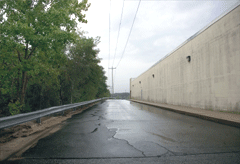
(Photo: Brian Rosa)
SRISKANDARAJAH: So these two guys – a cartographer …
ROSA: My name is Brian Rosa.
SRISKANDARAJAH: ...and a photographer …
RYDER: My name's Adam Ryder
SRISKANDARAJAH: … have been fascinated by power lines from a very young age.
RYDER: I spent a long time in the car with my parents on really long car rides, and I was an only child, so I would be looking out the window a lot.
SRISKANDARAJAH: Looking out the window, Brian and Adam both noticed the gently undulating curvy lines.
ROSA: I used to follow them with my finger kind of going up and down in almost sort of like a wavelength pattern when I was in the car.
[MUSIC: “I DON'T HAVE TO TRY. I DON'T HAVE TO SPEAK. I CAN WATCH THE COUNTRY SIDE.” THE SOUND OF A CAR STARTING. MUSIC: “AND I CAN FALL ASLEEP”]
SRISKANDARAJAH: There's something dreamy about the power lines and the land under them.
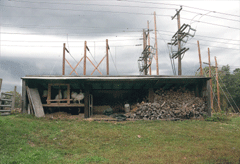
(Photo: Brian Rosa)
RYDER: Yeah absolutely, it’s a really unique tract of land that doesn’t have any development on it except for itself. So, it’s kind of, in a way its really pristine and untouched and…virginal, its kind of, kind of like, romantic and magical in that way.
SRISKANDARAJAH: Something inviting…
RYDER: It doesn’t appear to be monitored and there’s nobody out there so you can kind of imagine yourself or I would imagine myself like building a little house out there you know, living alone or something
SRISKANDARAJAH: Well young Adam didn’t end up moving there.
RYDER: [Laughs] I’d like to think he was that cool.
SRISKANDARAJAH: But this past year he and Brian got a grant from Rhode Island’s Arts Council to investigate and photograph the high-tension lines that stretch over most of Rhode Island. So they drove out to a small town called Burrillville parked their car and started walking.
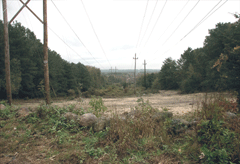
(Photo: Brian Rosa)
RYDER: When I got out of the car I tended to walk along the power lines in whatever the way was opposite of the way Adam was going
[COUNTRY SOUNDS]
SRISKANDARAJAH: And that’s when Brian heard something strange
ROSA: When we first started walking along the power lines I thought that there were a lot of cicadas -
[CICADA HUM]
ROSA: It didn’t actually occur to me that there is this excess energy escaping from these power lines that are actually making a constant electronic hiss all the time
[ELECTRICITY HUM]
SRISKANDARAJAH: These seemingly empty swatches of land are filled with sound.
ROSA: They make a loud buzzing sound
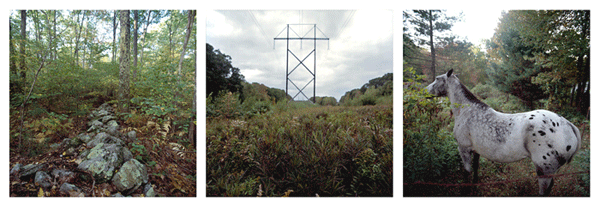
(Adam Ryder)
SRISKANDARAJAH: Maybe you have noticed some sort of sound too as you are driving by pole after pole after pole.
RYDER: They definitely provide a rhythm if you are driving past them on the highway, like if you are a commuter going past all these poles and they are evenly spaced.
[SOUND OF CARS PASSING]
RYDER: yeah- they kind of create a visual rhythm as they travel along the state.
[SOUND OF CAR DRIVING, MUSIC]
SRISKANDARAJAH: Like a heartbeat. These pillars are more than just dead trees…they really have a life of their own. As Brian and Adam continued to hike along the lines they saw that the land under and around the pylons is filled with a lot more than just sound.
ROSA: We were probably trespassing while we were there. There were a whole lot of other people doing that too - walking their dogs, riding their ATVs.
RYDER: We even found a stop sign on one of the power line poles and it was really crazy- I couldn’t figure out why it was there or who it was meant to protect but it seemed to be put up for motocross people or something! It was totally funny!
SRISKANDARAJAH: With a bit of amateur archeology Brian turned up even more.
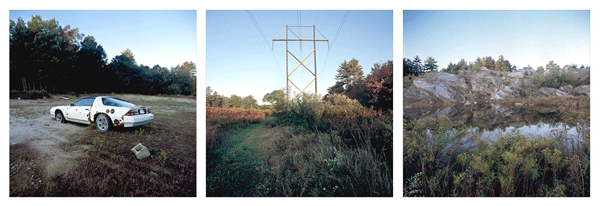
(Adam Ryder)
ROSA: Just seeing a fire pit that someone made and a few rocks with a wooden board across them where someone was sitting and people would just go have fires and sit around and drink and be delinquent and it kind of made me think back to my teenage years a little bit.
SRISKANDARAJAH: The power lines carve out a space for people to meet - but Brian and Adam say they connect us in another way.
ROSA: By following these power lines which seemed to cut through disparate areas that aren’t necessarily connected when looking from above you actually see that there is a continuum of rural to suburban to urban back to suburban to industrial and that they are all part of a vast network
RYDER: What’s really - I think actually awesome, is the best word I can use to say it - what’s really awesome about seeing this parade of power lines through the landscape, especially in rural areas is that we’re kind of seeing these, these tendrils connecting humanity as one large organism and it’s a cool way of looking at us, you know what I mean?
SRISKANDARAJAH: These are the power lines that bind. For Living on Earth I’m Ike Sriskandarajah.
[MUSIC: Arcade Fire “In The Backseat” from Funeral (Merge Records 2004)]
CURWOOD: Brian Rosa and Adam Ryder’s power line photographs and maps are on display at the Stairwell Gallery in Providence, Rhode Island through February fifth. Or, to see some of the pair’s photos, visit our website, loe.org.
Related link:
Power Line Project
CURWOOD: On the next Living on Earth… Alfred Hitchcock’s movie “The Birds” thrilled and chilled audiences when it was released in the 1960’s. But few viewers knew it was based on real-life events.
KUDELA: The movie suggested they were actually attacking people. What was probably happening is that they were poisoned and disoriented and simply flying into things.
CUROOD: And the mysterious poisoning is still happening today. What’s sickening California wildlife? Next time on Living on Earth.
[SOUND OF HEAVY WINDS]
CURWOOD: We leave you this week with a blast of winter
[SOUND OF HEAVY WINDS: Chris Watson “Glen Cannich, Inverness-shire, Scotland” from Stepping Into The Dark (Touch records 1996)]
CURWOOD: Recordist Chris Watson bared the frigid weather in the remote Glen Cannich, in Inverness-Shire, Scotland to capture the heavy winds. He managed to record for ten minutes before the gale forces blew over his microphones. BRRRRRR……..
Living on Earth is produced by the World Media Foundation. Our crew includes Ashley Ahearn, Bobby Bascomb, Eileen Bolinsky, Bruce Gellerman, Ingrid Lobet, Helen Palmer, Mitra Taj and Jeff Young, with help from Sarah Calkins and Marilyn Govoni. Our intern is Liz Gross. Jeff Turton is our technical director. Alison Lirish Dean composed our themes. You can find us anytime at loe.org.
I’m Steve Curwood. Thanks for listening and send some blankets.
ANNOUNCER: Funding for Living on Earth comes from the National Science Foundation, supporting coverage of emerging science, and Stonyfield Farm: organic yogurt and smoothies. Stonyfield pays its farmers not to use artificial growth hormones on their cows. Details at stonyfield.com.
Support also comes from you our listeners, the Ford Foundation, the Town Creek Foundation, the Oak Foundation supporting coverage of climate change and marine issues; the Skoll Foundation, supporting social entrepreneurs around the world – uncommon heroes dedicated to the common good. Learn more at skoll.org; and Pax World Mutual Funds: socially and environmentally sustainable investing. Pax World: for tomorrow. On the web at paxworld.com.
ANNOUNCER: PRI, Public Radio International.
Living on Earth wants to hear from you!
Living on Earth
62 Calef Highway, Suite 212
Lee, NH 03861
Telephone: 617-287-4121
E-mail: comments@loe.org
Newsletter [Click here]
Donate to Living on Earth!
Living on Earth is an independent media program and relies entirely on contributions from listeners and institutions supporting public service. Please donate now to preserve an independent environmental voice.
NewsletterLiving on Earth offers a weekly delivery of the show's rundown to your mailbox. Sign up for our newsletter today!
 Sailors For The Sea: Be the change you want to sea.
Sailors For The Sea: Be the change you want to sea.
 The Grantham Foundation for the Protection of the Environment: Committed to protecting and improving the health of the global environment.
The Grantham Foundation for the Protection of the Environment: Committed to protecting and improving the health of the global environment.
 Contribute to Living on Earth and receive, as our gift to you, an archival print of one of Mark Seth Lender's extraordinary wildlife photographs. Follow the link to see Mark's current collection of photographs.
Contribute to Living on Earth and receive, as our gift to you, an archival print of one of Mark Seth Lender's extraordinary wildlife photographs. Follow the link to see Mark's current collection of photographs.
 Buy a signed copy of Mark Seth Lender's book Smeagull the Seagull & support Living on Earth
Buy a signed copy of Mark Seth Lender's book Smeagull the Seagull & support Living on Earth

